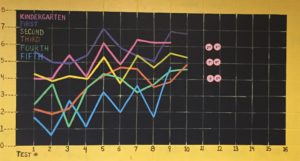Teachers today are surrounded with data; formative, summative, demographic, behavioral, non-cognitive… the list goes on and on. At times, teachers can feel like there is too much data and too little time to discuss what the numbers mean for students. One way to help students understand and relate to data is to anchor the data in the classroom. By posting the information, students are reminded of their data and upcoming goals. Here are four suggestions for using data walls effectively.
- Use appropriate, student-involved goals– Data walls are great tools when combined with goal-setting. Teachers can set individual goals with students or create opportunities for group goal-setting. With goals in hand, create a data wall for students to mark their desired growth. Creating this type of data wall is powerful because students are active participants in the process and product. Be mindful that the goals are both realistic and anonymous. Protecting students in this way means they will see the chart as encouraging versus threatening.
- Be consistent– When creating data walls based on formative data, consistency of scoring is key. If you’re constantly changing the target, students do not know where to aim. Through consistent grading practices, students feel more confident about what is expected and how to reach those goals.
- Include non-academic talents, too– Data charts around standardized tests such as NWEA have become common practice in many schools and classrooms, yet there are some students who might not feel successful on these measures. With data walls featuring non-cognitive skills such as perseverance, taking responsible risks, and listening with understanding and empathy, students can see that talents outside of academics are also valued in the classroom.
- Revisit the data often– Lastly, when putting up data walls, make sure to hang them in a location that is easily accessible and encourages frequent discussion. By drawing students’ attention to the data walls habitually, students see that the data is significant and keeps their focus on reaching their goals.


